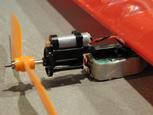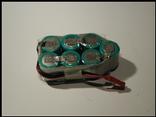
I started out in RC airplane modelling with the Tiger Moth, which is a three-channel model (throttle, rudder, elevator). I wanted to try my hand at an aileron-equipped model and the Tiny looked like a good model. I also enjoy building models, so I downloaded the plans from the internet (www.rcmicroflight.com) and began construction.
I didn't have carbon fiber (CF) rod available, so I used a stiff balsa stick that I had on hand. It worked fine and was actually lighter than the rod. However, the tail tended to flex relative to the wing - I don't know if this affected the handling or not - I'm too new to the hobby to be able to tell. I later changed to a CF rod. I attached the motor directly to the CF rod after using a file to create a flat spot on both the top and bottom of the rod (clean up the dust immediately - it is very fine and isn't very healthy), then slide the motor right on. The disadvantage is that if you crash, the motor is likely to break.
I took one of my scales with me to the hobby shop and selected some light weight 1/16-inch balsa (yes, it's a bit nerdy to stand there and go through the balsa weighing the sheets that look good). The result is a lighter plane that flies better. I also decided to omit the landing gear since they add weight and drag. I fly from grassy fields which makes landing gear useless. It is generally not a problem to do belly landings in soft grass (watch out for sticks that will puncture the wing covering).
Make sure to follow the directions on the plans for the +- 1/2-inch throw on the ailerons and elevator. Otherwise, you'll have a *very* responsive controls!
After switching to the CF rod, I found that the receiver didn't operate very well. Its range was significantly reduced when the antenna is parallel to the CF rod, resulting in glitching which has caused two crashes. I'm going to try different receivers to see if the glitching is related to the receiver type.
Todd Long, the designer, specifies a DC1717 coreless motor and carbon
fiber prop. I didn't have these handy so I used a GWS DX-A motor
mounted on the end of the fuselage (see photo). The prop is a GWS
10x4.7. I've done thrust tests with this motor and different props and
have found the 10x4.7 to provide the highest thrust. Other people use
the 9x7 prop, which would be my second choice.

I have a DC1717 motor and a 28cm x 12cm (11x4.7 inch) carbon fiber prop on order. The DC1717 gearbox I have is 11:1. I've found that with this combination doesn't work well using 7.2 volt packs. I'm now using three LiIon cells, which is a heavy pack and probably too much voltage for the motor. I've ordered the 6.3:1 gearbox and will mount that and try it at 7.2 volts.
Other people have attached the GWS motor to a small balsa stick which is then glued to the CF rod. The advantage is that the balsa stick will break upon a crash instead of breaking the motor or plane.
Some people are using the M100 motor, which has more thrust for a
small additional weight. The reports on using it are good. Expect
Tiny to no longer be a slow flyer with the M100 - more weight from the
motor and larger battery pack will increase wing loading and will need
higher speed to fly.

I use a either a 6-cell 150mAh NiCd GWS battery pack or a home-built 7-cell 270mAh NiMh battery pack. The GWS pack will fly well for a couple of minutes before the plane becomes sluggish. The 7-cell pack provides more thrust due to a higher RPM as well as a longer run time due to its higher capacity. The 150mAh battery is shown on the Batteries page and the 270mAh pack is in this photo.
Tiny is definitely not a first plane. It is much more responsive than the Tiger Moth. Having ailerons allows me to play with inverted flight, outside loops, and other things the Tiger Moth won't do. Other than the electronics and motors, it is an inexpensive plane to build.
It's interesting to see Todd's design pop up in various places. It appears as an ARF in the Hobby Lobby catalog as model TT090 and TT091, "Triange Classic" or "Triangle V" ARF Aerobatic streetflyer. A similar design is found in the "And_Now" plane but with depron wings instead of balsa. I'm considering building it in the near future as an example of a simple plane that could be used by many people in the local club. Low cost, easy to build, and durable. It would be easy to scale up to 30" wing span and outfit with an M100 motor and 700mAh batteries.
I've changed to a DC1717 motor with the 11:1 ratio gearbox driving a Wes 28x12cm carbon fiber prop. This combination weighs about 12 grams (1/2 ounce) less than the GWS equipment I initially used. The 7-cell battery pack doesn't generate enough voltage to turn the prop fast enough for anything but slow flight. I created a 3-cell 820mAh Lithium Ion battery pack (see batteries) and it works great. Tiny can loop from level flight and almost go vertical. Flight times are over 15 minutes with this pack.
The next experiment is with a two-cell 550mAh LiIon pack, the CF prop, and DC1717 motor with the 6.3:1 gearbox.